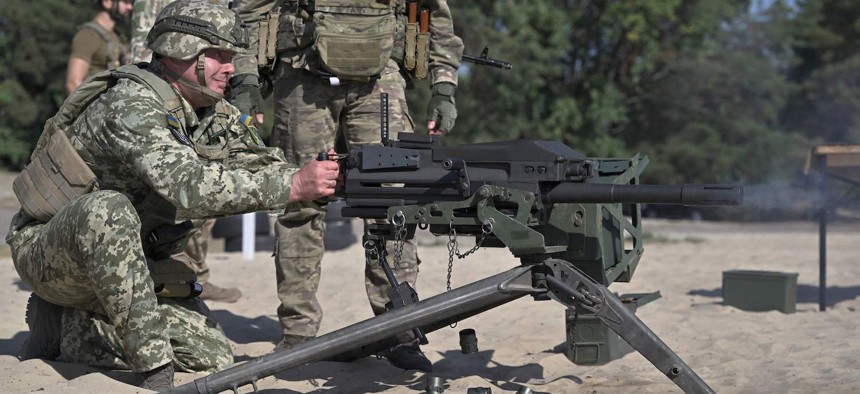
Commander of the Joint Forces the Armed Forces of Ukraine, lieutenant general Serhiy Nayev, fires a U.S.-made MK19 automatic grenade launcher during a military training exercise in Kyiv region on September 27, 2023. GENYA SAVILOV / AFP via Getty Images
More than $1 billion in high-tech military aid sent to Ukraine incorrectly tracked, watchdog finds
Poor interagency coordination and a lack of U.S. staff on the ground meant advanced weaponry was not accurately monitored in Defense Department databases.
The Pentagon failed to properly update the inventory status of more than a billion dollars in high-tech weapons sent to Ukraine, but this tracking is getting better, according to a report from the Defense Department investigator general.
Between February 2022, when Russia launched its full-scale invasion of Ukraine, and last June, the U.S. sent the beleaguered country $1.69 billion dollars worth of weapons that require a stringent form of tracking called enhanced end-use monitoring. Most such weapons are missiles, including anti-aircraft Stingers and anti-tank Javelins. Such monitoring includes tracking when the weapons are expended or lost.
The inspector general’s investigators found that U.S. officials did not keep weapons tracking databases updated in a timely manner due to a host of problems, including under-staffing, security concerns, a failure to communicate across multiple federal organizations, and Ukraine occasionally providing information too slowly.
Beginning in January 2022, the U.S. rushed to ship Javelin anti-tank missiles to Kyiv in large numbers as Russia’s army gathered on the border with Ukraine. That military aid quickly swelled to include everything from night vision goggles to AeroVironment attack drones, clocking in today at $46 billion worth of security assistance.
Even as an ocean of military aid began to pour into Ukraine, the Pentagon had no staff within the country tracking weapons transfers because of the shuttering of the U.S. embassy, which stayed closed from February to May. In July 2022, or five months into the war, U.S. inspectors from the Office of Defense Cooperation established a larger enhanced end use monitoring operation in a partner nation.
Staffing, however, remained a problem. For one location, only one ODC inspector was available to inventory equipment sent to multiple logistics hubs located in the partner country. ODC inspectors eventually returned to Ukraine in small teams in November 2022.
Inside Ukraine, inspectors were further constrained by security considerations. Weapons sent to Ukraine’s forces were often soon on the front line, where the inspectors cannot travel, according to Defense Department policy.
Even if access was unrestricted, the limited number of staff in Ukraine and the “unprecedented” volume of goods made standard inventorying practices impractical, said the Office of Defense Cooperation in a memorandum to the inspector general.
The accuracy of tracking improved over time, the report noted. In February 2023, 87 percent of items were incorrectly updated; in July, that was down to 56 percent of items.
To add to the problem, the Defense Department itself did not update the list of weapons sent to Ukraine in a timely manner, waiting up to 27 days after a transfer for at least one weapon. In some cases, their transfer date was entered by the Office of Defense Cooperation inspectors or Ukraine itself.
Technology problems also played a role. At one point, “thousands” of scans by Ukrainian army personnel had not been uploaded by the U.S. to a key database for tracking weapons, the report said. Other data entries have been further delayed by expenditure records that are in Ukrainian, and have not been translated.
Ukraine, meanwhile, was also delinquent in updating the database at times. Neither the Office of Defense Cooperation nor Ukrainian forces inventoried a sample of 68 Stinger anti-air missiles grip stocks, the report said. Night vision goggles lost in March 2022, or just weeks into the invasion, were not recorded as lost until January 2023, the report said.
“We are in a full-scale war. Once we definitely know it was lost, we report it,” said Oleksandra Ustinova, a Ukrainian parliamentarian who has led end-use monitoring efforts for Ukraine.
With Ukraine battling across multiple fronts in hectic combat, Ustinova noted that the nation has not yet been able to resolve the fates of 8,000 soldiers who are missing-in-action.
The report did not indicate that any weapons provided to Ukraine had been diverted through Ukrainian corruption or negligence.
U.S. inspectors have “24/7 access, they can come at 2 in the morning and see where every Javelin is,” Ustinova said, and noted one story in which a soldier had been killed by Russian shelling while attempting to prevent a Javelin from being left behind.
The U.S. needs to “show leadership” when it comes to implementing the tracking system, said former Ambassador to Ukraine John Herbst, who advocated for increasing the number of inspectors.
“A country fighting a war has limited resources” for tracking weapons, he said, referring to Ukraine.
The U.S. could achieve that by hiring contractors to perform the inspections, which would avoid the political implications of a greater official U.S. presence, said Mark Cancian, a senior advisor at the Center for Strategic and International Studies.
Ukraine’s failings to accurately track the weapons expenditure, meanwhile, was at times understandable, he added.
“When you’re facing Russian tanks, filling out the paperwork is not too high on the list” of priorities, he said.
NEXT STORY: US, allies strike Houthi targets



